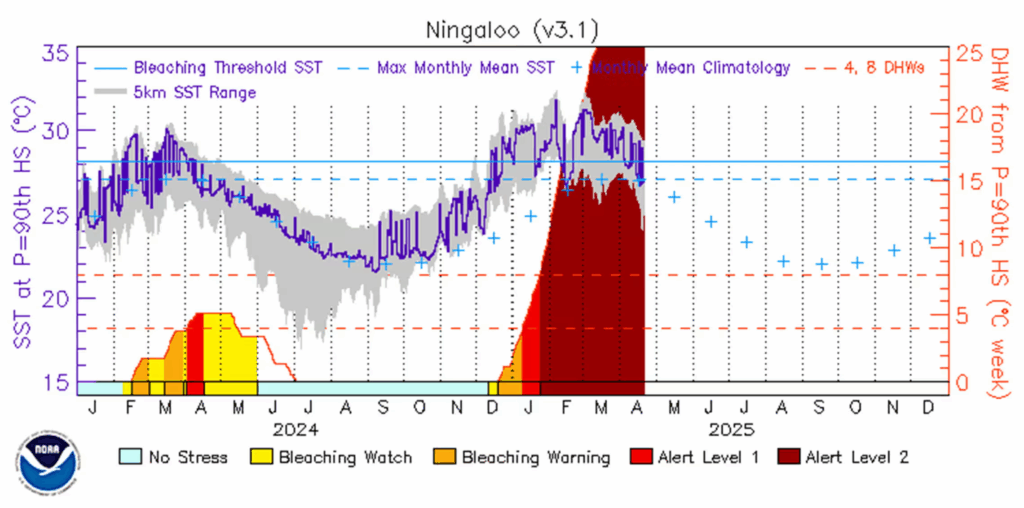The main purpose of this ongoing blog will be to track planetary extreme, or record temperatures related to climate change. Any reports I see of ETs will be listed below the main topic of the day. I’ll refer to extreme or record temperatures as ETs (not extraterrestrials).😉
Main Topic: More than 80% of World’s Reefs Hit by Bleaching After Worst Global Event on Record
Dear Diary. The world’s reefs, which are actually oceanic jungles teaming with fish and other wildlife, get stunted during every El Niño episode as anomalously warm waters in association with each event causes bleaching. Last year’s El Niño event wasn’t particularly strong, but ocean basins worldwide had anomalously warm water due to climate change.
It’s no wonder that a record 80% of the world’s reefs got hurt during this last bleaching episode since the last two years have been the warmest on record.
Here are more details by the Guardian:
More than 80% of the world’s reefs hit by bleaching after worst global event on record
An ashen pallor and an eerie stillness all that remains where there should be fluttering fish and vibrant colours in the reefscape, one conservationist says

Wed 23 Apr 2025
The world’s coral reefs have been pushed into “uncharted territory” by the worst global bleaching event on record that has now hit more than 80% of the planet’s reefs, scientists have warned.
Reefs in at least 82 countries and territories have been exposed to enough heat to turn corals white since the global event started in January 2023, the latest data from the US government’s Coral Reef Watch shows.
Coral reefs are known as the rainforests of the sea because of their high concentration of biodiversity that supports about a third of all marine species and a billion people.
But record high ocean temperatures have spread like an underwater wildfire over corals across the Pacific, Atlantic and Indian oceans, damaging and killing countless corals.
“The fact that so many reef areas have been impacted … suggests that ocean warming has reached a level where there is no longer any safe harbor- Dr Derek Manzello
The 84% of reefs exposed to bleaching-level heat in this ongoing fourth event compares with 68% during the third event, which lasted from 2014 to 2017, 37% in 2010 and 21% in the first event in 1998.
Even reefs considered by scientists to be refuges from the ocean’s rising levels of heat have been bleached, Dr Derek Manzello, the director of Coral Reef Watch, said.
“The fact that so many reef areas have been impacted, including purported thermal refugia like Raja Ampat and the Gulf of Eilat, suggests that ocean warming has reached a level where there is no longer any safe harbour from coral bleaching and its ramifications,” he said.
“The fact that so many reef areas have been impacted, including purported thermal refugia like Raja Ampat and the Gulf of Eilat, suggests that ocean warming has reached a level where there is no longer any safe harbour from coral bleaching and its ramifications,” he said.
Many areas have seen bleaching in back-to-back years, including the world’s biggest reef system, Australia’s Great Barrier Reef, where last week authorities declared a sixth widespread bleaching event in just nine years.

The heritage-listed Ningaloo reef off Western Australia has seen its highest level of heat stress on record. Composite: Coral Reef Watch
Australia’s other World Heritage-listed reef along the Ningaloo coast in Western Australia has seen its highest levels of heat stress on record in recent months.
Scientists on the other side of the Indian Ocean have reported bleaching in recent weeks affecting reefs off Madagascar and the east African coast, including South Africa’s World Heritage iSimangaliso wetland park.
Dr Britta Schaffelke, of the Australian Institute of Marine Science and coordinator of the Global Coral Reef Monitoring Network (GCRMN), said the event was unprecedented. “Reefs have not encountered this before.”

The aftermath of a severe coral bleaching event in 2024 on the Great Barrier Reef. Photograph: Grumpy Turtle Films
“With the ongoing bleaching it’s almost overwhelming the capacity of people to do the monitoring they need to do,” she said. “The fact that this most recent, global-scale coral bleaching event is still ongoing takes the world’s reefs into uncharted waters.
“[For] people who spend their entire working lives on monitoring and observing reefs and protecting reefs, and living alongside them and relying on them, seeing something like this must be devastating.
“Ecological grief is real. People who spend a lot of time under the water see it changing before their eyes,” she said.
The GCRMN is collating monitoring data for a status report due out next year, but Schaffelke said even that report would not give a full picture of the impact of the event.
An animated heatmap showing detected temperatures across coral reefs worldwide from 1 Jan 2023 to 20 April 2025.
Scientists in north and central America, including Florida, the Caribbean and Mexico, were among the first to raise the alarm after record ocean temperatures saw extreme bleaching in the northern hemisphere’s summer of 2023.
Corals can recover from bleaching if temperatures are not too extreme, but surveys done in the months after the event have begun to paint a picture of widespread coral death
Across Florida, an average of one in five corals were lost. On the Pacific side of Mexico, one area lost between 50% and 93% of its corals. Almost a quarter of corals were killed by heat last year in the remote Chagos Islands in the middle of the Indian Ocean.
Scientists described a “graveyard of dead corals” in the northern section of the Great Barrier Reef after bleaching in early 2024 that caused 40% of corals to die in one area in the south.
After the extreme heat of 2023, Coral Reef Watch was forced to add three new threat levels to its global bleaching alert system to represent the unprecedented heat stress corals had faced.
Melanie McField, the founder of the Healthy Reefs for Healthy People initiative in the Caribbean, said reefs had fallen quiet across the world.
“Bleaching is always eerie – as if a silent snowfall has descended on the reef … there is usually an absence of fluttering fish and an absence of the vibrant colours on the reef,” she said. “It’s an ashen pallor and stillness in what should be a rowdy vibrant reefscape.”

Bleached corals after the 2023 bleaching event that hit reefs in the Mexican Caribbean and the northern section of the Mesoamerican reef. Photograph: Lorenzo Alvarez-Filip
Dr Lorenzo Álvarez-Filip, a coral scientist at the National Autonomous University of Mexico, has been surveying reefs across the Mexican Caribbean and the Gulf of Mexico after the bleaching in 2023 and again in 2024.
He said the most devastating impact was the loss of reef-building corals, such as elkhorns, that help protect coastlines and support a multitude of other marine life.
“Many of the coral colonies I knew well, and which had survived [a major disease] outbreak just a few years earlier, died in a matter of weeks.
“The feeling of impotence combined with the need to at least document what was happening made me very anxious – this was particularly hard when we were about to dive in sites where we knew there were big aggregations of susceptible corals. In almost all cases, we ended up with a very depressing feeling when we confirmed that all or nearly all the coral had died.”
Dr Valeria Pizarro, a senior coral scientist at the Perry Institute for Marine Science that works on reefs in the Bahamas and Caribbean, witnessed extreme bleaching in the Bahamas in July 2023.
She said “in a blink of my eyes” shallow reefs became white landscapes, with widespread death among staghorn corals used in restoration projects. Spectacular sea fans and soft corals died quickly.
“It was like they were melting with the heat,” she said.
“World leaders need to really commit to reduce fossil fuels and increase investments in clean energies and make it a reality. We need them to stop having it on paper and on the news, we need it to be real.”
Here are more “ET’s” recorded from around the planet the last couple of days, their consequences, and some extreme temperature outlooks, as well as any extreme precipitation reports:
Here is More Climate News from Friday:
(As usual, this will be a fluid post in which more information gets added during the day as it crosses my radar, crediting all who have put it on-line. Items will be archived on this site for posterity. In most instances click on the pictures of each tweet to see each article. The most noteworthy items will be listed first.)